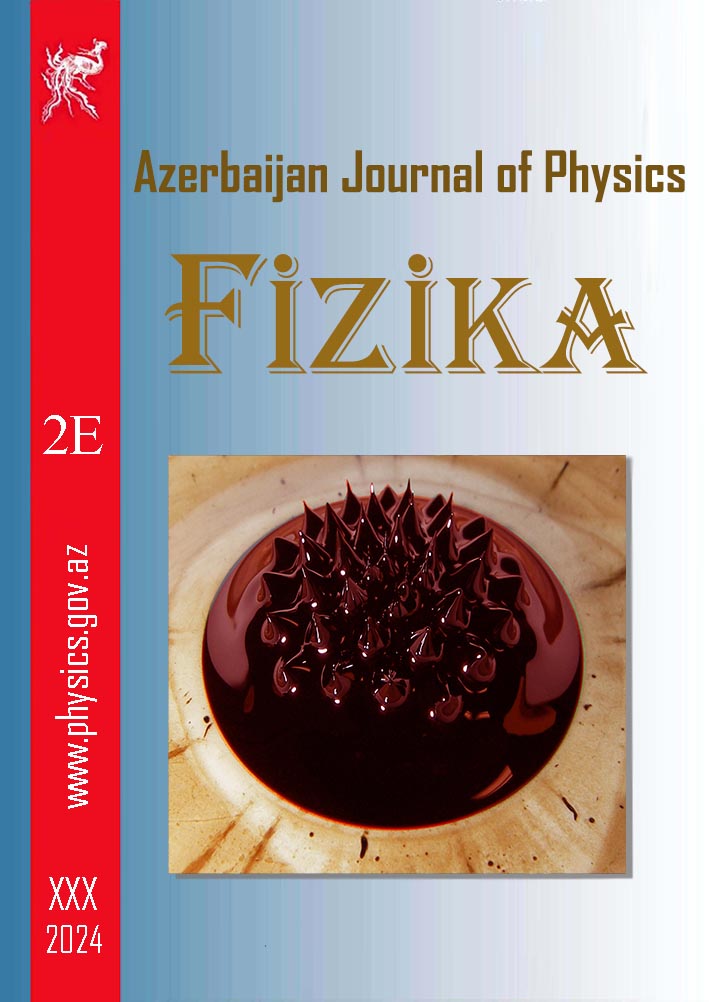ABSTRACT
The method of microscopic recombination scattering was used to assess the conformational changes in hemoglobin under the influence of sodium nitrite (NaNO2)
taken in small (0-0.35 μM) and moderate (0.35-0.70 μM) final concentrations and sodium selenite (Na2SeO3 - 5μM) in incubation medium containing human
erythrocytes (incubation time 30 min). Under the influence of NaNO2, there is a dose-dependent decrease (up to 60%) in HbO2 content, an increase
(≈ 25%) in the ability of hemoglobin to bind ligands and an increase (≈12%) in the ability of hemoglobin to release ligands (О2), as well as an increase
(up to 13%) in the severity of symmetric and asymmetric pyrolic hematoporphyrin rings. Sodium selenite reduces the oxidative effects of sodium nitrite decreasing the
increase in MetHb accumulation and a decrease of hemoglobin saturation by oxygen.
Keywords: sodium nitrite, sodium selenite, hemoglobin, erythrocytes, Raman scattering.
PACS:
Received: 17.11.2020
AUTHORS & AFFILIATIONS
Institute of Biophysics of Azerbaijan NAS 117, Zahid Khalilov str., Baku, AZ 1141
E-mail: tokhus@mail.ru
|
REFERENCIES
[1] A.W. DeMartino, D.B Kim-Shapiro, R.P. Patel, M.T. Gladwin. Nitrite and Nitrate Chemical Biology and Signalling. Br J Pharmacol. 2019;176(2):228-245. doi: 10.1111/bph.14484.
[2] E.I. Nasybullina, O.V. Kosmachevskaya, A.F. Topunov. Influence of nitric oxide metabolites on the formation of membrane-bound hemoglobin under carbonyl stress. "Fundamentals of Biotechnology" RAS, Moscow, Russia. 2018; 4: 93–104. doi: 10.17076 / them814.
[3] A.F. Vanin. Dinitrosyl iron complexes with thiol- containing ligands as a «working form» of endogenous nitric oxide, nitric Oxide Biol. Chem. 2016; 54: 15-29.
[4] A.K. Martusevich, A.G. Solovieva, S.P. Peretyagin, A.F. Vanin. Comparative analysis of the effect of free and deposited NO on the state of pro- and antioxidant systems in the blood. "Biophysics". 2015; 60 (2): 348-354.
[5] Duke researchers discover central role of Nitric Oxide in hemoglobin action. Duke Medicine News and Communication. 3 Nov. 2004. dukehealth.org
[6] M.K. Ruban, G.A. Vashanov, I.A. Lavrinenko. Oxygenation-induced structural and functional modifications of nitrosylated hemoglobin. VSU Bulletin, series: chemistry. biology. pharmacy, 2010;1:56-61.
[7] A.I. Hobbs, M.T. Gladwin, R.P. Patel, D.L.H. Williams, A.R. Butler. Haemoglobin: NO transporter, NO inactivator or none of the above .TRENDS in Pharmacological Science. 2002; 23: 406–411.
[8] P.K. Maurya, P. Kumar, P. Chandra. Biomarkers of oxidative stress in erythrocytes as a function of human age. World J Methodol. 2015; 5(4): 216–222. doi: 10.5662/wjm.v5.i4.216.
[9] S. Rocha, D. Gomes, M. Lima, E. Bronze-da-Rocha, Santos-Silva A. Peroxiredoxin 2, glutathione peroxidase, and catalase in the cytosol and membrane of erythrocytes under H2O2-induced oxidative stress. Free Radic Res. 2015;49(8):990-1003. doi: 10.3109/10715762.2015.1028402.
[10] M.A. Beilstein, P.D. Whanger. Distribution of selenium and glutathione peroxidase in blood fraction from humans, rhesus and a querel monkeys, rats and sheep. J. Nutr; 1983; 113(11):2138-2146. doi:10.1093/jn/113.11.2138.
[11] R.F. Burk, K.E. Hill. Regulation of Selenium Metabolism and Transport. Annu Rev Nutr 2015;35:109-34. doi: 10.1146/annurev-nutr-071714-034250.
[12] T.M. Huseynov, F.R. Yakhyaeva, R.T. Gulieva. Effect of selenium on the resistance of hemoglobin to photooxidative processes. Ukrainian Biochemical Journal. 2012; 84( 2): 53-60.
[13] K.T Suzuki, Y. Shiobara, M. Itoh, M. Ohmichi. Selective uptake of selenite by red blood cells. Analyst. 1998;123(1):63-67. doi: 10.1039/a706230c.
[14] M. Haratake, K. Fujimoto, M. Ono, M. Nakayama. Selenium binding to human hemoglobin via selenotrisulfide. Biochim Biophys Acta. 2005; 25;1723(1-3):215-220. doi:10.1016/j.bbagen.2005.02.002.
[15] D.A. Vitturi, C.W. Sun, V.M. Harper. Antioxidant Functions for the Hemoglobin β93 Cysteine Residue in Erythrocytes and in the Vascular Compartment in Vivo. Free Radic Biol Med.2013; 55:119-29. doi: 10.1016/j.freeradbiomed.2012.11.003.
[16] U.M. Viswanathan, T. Burkholz and C. Jacob. Electrochemistry at the edge of reason: Chalcogen-based redox systems in biochemistry and drug design, Zeitschrift für Physikalische Chemie, 227(5): 691-706 (2013). doi.org/10.1524/zpch.2013.0321
[17] G.V. Maksimov, N.A. Brazhe, A.I. Yusipovich, E.Yu. Parshina, O.V. Rodnenkov, A.B. Rubin, G.G. Levin, V.A. Bykov. The use of nanoparticles to study the conformations of the approximate hemoglobin. Biophysics, 2011; 56( 6):1099-1104
[18] P. Ivo, J. Terner, R.N. Pittman, E. Proffitt and K.R. Ward. Measurement of hemoglobin oxygen saturation using Raman microspectroscopy and 532-nm excitation. J Appl Physiol. 2008; 104: 1809–1817. doi:10.1152/japplphysiol.00025.2008.
[19] M.F. Zhu, Y.Y. Huang, Z.Y. Guo, Z.F. Zhuang, S.H. Liu. Detection of methemoglobin in whole blood based on confocal micro-raman spectroscopy and multivariate statistical techniques. Scanning 2014; 36: 471–478. doi: 10.1002/sca.21143
[20] S.Y. Huseynova, T.M. Huseynov, M.Z. Dadashov. Oxidative modification of hemoglobin by nitrites and the protective role of selenium. Possibilities of Raman spectroscopy. Azerbaijan journal of physics. Baku, 2015; 21(03): 16-20.
[21] S.Y. Huseynova. Oxidative metabolism of sodium selenite in isolated human erythrocytes in vitro. Biomedicine (Baku).2019;17(3):18-23. doi: 10.24411/1815-3917-2019-10018
[22] J. Szebeni, C.C. Winterbourn, R.W. Carrell. Oxi-dative interactions between haemoglobin and membrane lipid. A liposome model. Biochem. J. 1984. V. 220. № 3. P. 685–692
[23] G.F. Lakin. Biometriya.Moscow, 1990; 352 p.
[24] S.Y. Huseynova, R.T. Gulieva, M.Z. Dadashov, A.I. Jafarov, F.R. Yakhyaeva, T.M. Guseinov. Oxidative modification of hemoglobin of isolated erythrocytes in an incubation medium containing donors of nitric oxide and sodium selenite. Bulletin of the Novosibirsk State Pedagogical University. 2016; 6( 5):207-215.
[25] S.Y. Huseynova, T.M. Huseynov, M.Z. Dadashov. Oxidative modification of erythrocytes with moderate doses of sodium nitrite in in vitro experiments, Medical biophysics and biochemical chemistry. 2018;(3)1:189-195.
[26] H. Kosaka. Nitric oxide and hemoglobininteractions in the vasculature. Biochim. Biophys. Acta. 1999; 1411: 370–377.
[27] M.C. Garel, C. Domenget, J. Caburi-Martin, C. Prehu, F. Galacteros, Y. Beuzard. Covalent binding of glutathione to hemoglobin. I. Inhibition of hemoglobin S polymerization. J. Biol. Chem. 1986; 261:14704–14709.
[28] N.A. Brazhe, S. Abdali, R.A. Brazhe, O.G. Luneva et. al New insight into erythrocyte through in vivo surface-enhanced Raman spectroscopy Biophys J. 2009; 97(12): 3206–3214. doi: 10.1016/j.bpj.2009.09.029
[29] S.Y. Huseynova, T.M. Huseynov, M.Z. Dadashov. Evaluation of nitrite-induced oxidative modification of hemoglobin by Raman spectroscopy. Abstracts of the International Scientific Conference dedicated to the 90th anniversary of the National Academy of Sciences of Belarus and the 45th anniversary of the Institute of Biophysics and Cell Engineering, Belarus, Minsk, June 27-29, 2018 g, page 149.
[30] S.Y. Huseynova. Membrane-bound hemoglobin as an indicator of nitric toxicity of erythrocytes. Аzerbaijan chemical journal 2019, 2020 (2) : 67-73. doi.org/10.32737/0005-2531-2020-2-67-73.
|
